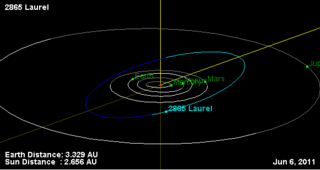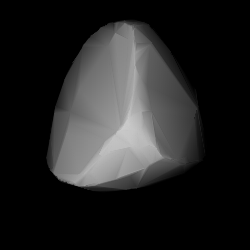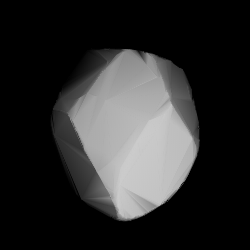
2865 Laurel, provisional designation 1935 OK, is a stony Marian asteroid from the middle region of the asteroid belt, approximately 15 kilometers in diameter. It was discovered by English-born South African astronomer Cyril Jackson at Johannesburg Observatory on 31 July 1935. The asteroid was named after movie comedian Stan Laurel.

327 Columbia is a stony asteroid from the middle region of the asteroid belt, approximately 26 kilometers in diameter. It was discovered on 22 March 1892, by French astronomer Auguste Charlois at Nice Observatory in southeast France. It is named after Christopher Columbus (1451–1506).
Lagrangea, provisional designation 1923 OU, is a carbonaceous background asteroid from the outer region of the asteroid belt, approximately 30 kilometers in diameter. It was discovered on 12 September 1923, by Russian astronomer Sergey Belyavsky at the Simeiz Observatory on the Crimean peninsula. The asteroid was named after Italian mathematician and astronomer Joseph-Louis Lagrange.
1057 Wanda, provisional designation 1925 QB, is a carbonaceous background asteroid from the outer region of the asteroid belt, approximately 43 kilometers in diameter. It was discovered by Grigory Shajn at the Simeiz Observatory in 1925, and later named after Polish–Soviet writer Wanda Wasilewska. The asteroid has a rotation period of 28.8 hours.
1155 Aënna, provisional designation 1928 BD, is an asteroid from the inner regions of the asteroid belt, approximately 11 kilometers in diameter. It was discovered on 26 January 1928, by German astronomer Karl Reinmuth at Heidelberg Observatory in southwest Germany. It is named for the astronomy journal Astronomische Nachrichten.
1157 Arabia, provisional designation 1929 QC, is an asteroid from the outer regions of the asteroid belt, approximately 29 kilometers in diameter. Astronomer Karl Reinmuth discovered it at the Heidelberg Observatory in southwest Germany on 31 August 1929. The asteroid was named for the Arabian Peninsula.
(9992) 1997 TG19 is a stony asteroid and eccentric Mars-crosser, approximately 4 kilometers in diameter. It was discovered on 8 October 1997, by Japanese astronomers Tetsuo Kagawa and Takeshi Urata at Gekko Observatory near Shizuoka, Japan.
6042 Cheshirecat ( or ), provisional designation 1990 WW2, is an eccentric, rare-type asteroid and large Mars-crosser from the outer regions of the asteroid belt, approximately 14 kilometers in diameter. It was discovered by Japanese astronomers Akira Natori and Takeshi Urata at the JCPM Yakiimo Station on 23 November 1990. It was named for the Cheshire Cat from the novel Alice's Adventures in Wonderland.

1328 Devota, provisional designation 1925 UA, is a dark background asteroid from the outermost regions of the asteroid belt, approximately 56 kilometers in diameter. It was discovered on 21 October 1925, by Russian–French astronomer Benjamin Jekhowsky at the Algiers Observatory in North Africa. The asteroid was named after Argentine astronomer Fortunato Devoto.
1736 Floirac, provisional designation 1967 RA, is a stony Florian asteroid from the inner regions of the asteroid belt, approximately 8.7 kilometer in diameter.
1409 Isko, provisional designation 1937 AK, is a carbonaceous background asteroid from the central regions of the asteroid belt, approximately 35 kilometers in diameter. It was discovered on 8 January 1937, by astronomer Karl Reinmuth at the Heidelberg-Königstuhl State Observatory in southwest Germany. The asteroid was named after Ise Koch, wife of astronomer Fritz Kubach.

1281 Jeanne is a dark asteroid from the background population of the intermediate asteroid belt. It was discovered on 25 August 1933, by astronomer Sylvain Arend at the Royal Observatory of Belgium in Uccle, who named it after his daughter, Jeanne. The likely P-type asteroid has a rotation period of 15.2 hours and measures approximately 22 kilometers in diameter.

1175 Margo, provisional designation 1930 UD, is a stony background asteroid from the outermost regions of the asteroid belt, approximately 24 kilometers in diameter. It was discovered on 17 October 1930, by astronomer Karl Reinmuth at the Heidelberg-Königstuhl State Observatory in southwest Germany. The meaning of the asteroids's name is unknown.

1841 Masaryk (prov. designation: 1971 UO1) is a carbonaceous background asteroid from the outer region of the asteroid belt, approximately 46 kilometers in diameter. It was discovered on 26 October 1971, by Czech astronomer Luboš Kohoutek at Bergedorf Observatory in Hamburg, Germany. The asteroid was named after the first President of Czechoslovakia, Tomáš Garrigue Masaryk.
2043 Ortutay, provisional designation 1936 TH, is a dark asteroid from the outer regions of the asteroid belt, approximately 45 kilometers in diameter. The asteroid was discovered by Hungarian astronomer György Kulin at the Konkoly Observatory, Budapest, on 12 November 1936. It was named after Hungarian ethnographer Gyula Ortutay.
1190 Pelagia, provisional designation 1930 SL, is a dark Nysian asteroid from the inner regions of the asteroid belt, approximately 17 kilometers in diameter. It was discovered on 20 September 1930, by Soviet–Georgian astronomer Grigory Neujmin at the Simeiz Observatory on the Crimean peninsula. The asteroid was named after astronomer Pelageya Shajn.

1350 Rosselia, provisional designation 1934 TA, is a stony Koronian asteroid from the outer regions of the asteroid belt, approximately 22 kilometers in diameter. Discovered by astronomer Eugène Delporte at the Royal Observatory of Belgium in 1934, the asteroid was later named after Marie-Thérèse Rossel, editor of the Belgian newspaper Le Soir.
4082 Swann, provisional designation 1984 SW3, is a carbonaceous asteroid from the inner regions of the asteroid belt, approximately 10 kilometers in diameter.
2995 Taratuta, provisional designation 1978 QK, is a stony Eunomian asteroid from the middle region of the asteroid belt, approximately 17 kilometers in diameter. It was discovered on 31 August 1978, by Russian astronomer Nikolai Chernykh at the Crimean Astrophysical Observatory, Nauchnyj, on the Crimean peninsula. The asteroid was later named after Soviet writer Yevgeniya Taratuta.

1400 Tirela is an asteroid and the parent body of the Tirela family, located in the outer regions of the asteroid belt. It was discovered on 17 November 1936, by French astronomer Louis Boyer at the Algiers Observatory in North Africa. The asteroid has a rotation period of 13.4 hours and measures approximately 16 kilometers in diameter. It was named after Charles Tirel, a friend of the discoverer.








